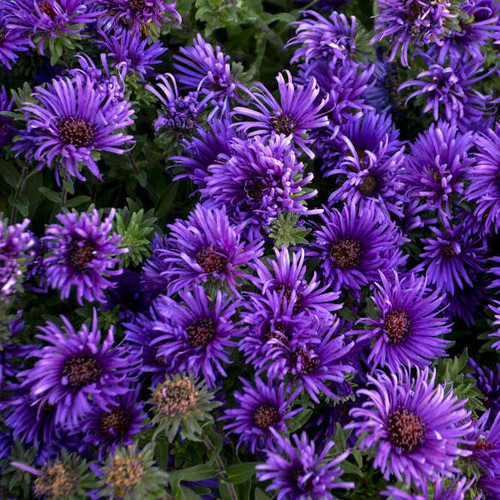Product Description
Aster novae-angliae 'Grape Crush' PP33612 (25) Bare Root Plants
Common Name: New England Aster
Bringing refinement to fall blooming Asters, 'Grape Crush' produces a large, very round mound with densely packed flowers. We have observed no lodging in our trials, a phenomenal achievement for fall blooming Asters. Very rich, dark purple flowers are produced above dark green foliage in early fall to midfall. A perfect finale to the growing season!
Asters are native to North America and are generally very easy to grow.
Asters perform best in rich, evenly moist soil and full sun. Give them lots of room to grow; good air circulation will help to prevent powdery mildew. Though this cultivar has a bushy, compact habit, it may still require staking. To promote dense growth that is less likely to flop, pinch plants back from late spring until July 4th.
Plants should be divided every couple of years in the spring to maintain their health and vigor.
Height: 26.0-30.0 Inches
Spread: 40.0-44.0 Inches
Hardiness Zones: 3,4,5,6,7,8
Flower Color: Purple shades
Foliage Color: Green shades
Full Sun
Average Water Needs
Fertile Soil Quality
Bloomtime: Early Fall
Attracts Butterflies
Bee Friendly
Seasonal Interest: Fall Color
Growth Rate: Medium
Border Plant, Cut Flower, Mass Planting, Salt Tolerant
Aster 'Grape Crush' is a beautiful and popular variety of New England Aster (Symphyotrichum novae-angliae). Here is what you should know about it:
Key Features:
- Vibrant Color: 'Grape Crush' boasts rich, dark purple flowers that are densely packed, almost covering the green foliage when in full bloom.
- Late Season Bloom: It flowers in late summer and fall, providing a burst of color when many other plants are fading.
- Mounding Habit: It grows in a neat, mounded shape, making it a great choice for borders and mixed plantings.
- Attracts Pollinators: Like other asters, 'Grape Crush' is a valuable source of nectar for butterflies and bees, supporting local ecosystems.
- Native Plant: As a North American native, it is well-adapted to many growing conditions and requires minimal maintenance.
Growing Conditions:
- Sunlight: Prefers full sun (at least 6 hours of direct sunlight daily) for optimal growth and flowering.
- Soil: Thrives in well-drained soil.
- Watering: Needs regular watering, especially during dry spells.
- Hardiness Zones: Suitable for USDA hardiness zones 3-8, meaning it can tolerate a wide range of temperatures.
Uses in the Garden:
- Borders: Its compact and mounding habit makes it perfect for edging borders or creating a colorful ground cover.
- Pollinator Gardens: A must-have for attracting butterflies and bees to your garden.
- Mixed Plantings: Combines well with other fall-blooming plants and adds a pop of color to perennial gardens.
- Cut Flowers: The long-lasting flowers can be enjoyed in bouquets and floral arrangements.
Additional Tips:
- To encourage bushier growth and more flowers, you can pinch back the stems in late spring or early summer.
- Deadheading spent flowers can help prolong the blooming period.
- Divide clumps every few years to prevent overcrowding and maintain vigor.
Aster 'Grape Crush' is a fantastic addition to any garden, offering vibrant color, attracting pollinators, and requiring minimal care. Its late-season blooms provide a welcome burst of beauty as summer fades into fall.
Other Details
The most important part of the plant is its root system. Healthy roots are the foundation of a healthy, vibrant plant. The type of plug container used is based on the specific needs of the plants. Perennials offered as bare root traditionally perform better when planted as bare root.Planted in a specialized mix, potted plants have well established root systems. Top growth stage will vary depending on the current life cycle and time of year when shipped. In Winter and early Spring dormant plants may be shipped. Dormant plants may be planted right away, even before the last frost date.
Most bare root varieties are field grown for at least one season, though Hemerocallis and Hosta are grown for two seasons. The bulk of the soil is removed during the harvesting process and the tops of most varieties are trimmed back to the crown. They are graded, packed in shredded aspen or sphagnum moss and stored in freezers until ready to be shipped.
See our Container Sizes and Bare Root Perennials pages for more information.
Plant information and care is provided in the Overview section, Plant Genus Page and general information is provided in the Planting Care & Guides. Additional questions can be asked on each Plant page.
Plant Spacing: Using the maximum mature spread or width of a plant to guide spacing, ensures space to grow to full size. To fill an area sooner, plant them closer together. Just remember, future thinning or transplanting may be needed.
Water: Keep a close eye on newly planted perennials, especially throughout the first growing year. Most early plant loss is due to too much or too little water!















